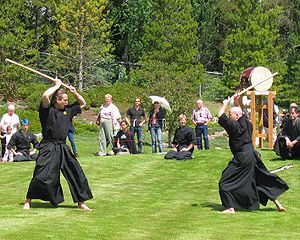
Jodan
Encyclopedia

Bujinkan
The Bujinkan is an international martial arts organization based in Japan and headed by Masaaki Hatsumi, it is best known for its association with ninjutsu. The system taught by this group, called Bujinkan Budō Tai jutsu, consists of nine separate martial arts traditions .-Origins:Hatsumi's...
practitioners, is a basic kenjutsu
Kenjutsu
, meaning "the method, or technique, of the sword." This is opposed to kendo, which means the way of the sword. Kenjutsu is the umbrella term for all traditional schools of Japanese swordsmanship, in particular those that predate the Meiji Restoration...
posture. Jōdan-no-kamae means upper-level posture (lit. 'high/upper degree posture').
Kendo
Jōdan-no-kamae is one of the five stances in kendoKendo
, meaning "Way of The Sword", is a modern Japanese martial art of sword-fighting based on traditional Japanese swordsmanship, or kenjutsu.Kendo is a physically and mentally challenging activity that combines strong martial arts values with sport-like physical elements.-Practitioners:Practitioners...
: jōdan, chūdan, gedan, hassō
Hasso-no-kamae
, frequently shortened simply to hassō and occasionally called hassō-gamae, is one of the five stances in kendo: jōdan, chūdan, gedan, hassō, and waki. It is an offensive stance, named for one's ability to respond to a situation in any direction...
and waki. In jōdan-no-kamae, the sword is raised above the head with the tip (kissaki) pointing back and the blade facing up, in readiness to strike. It is the most aggressive stance of the five.
There are commonly two types of jōdan-no-kamae, left (hidari) and right (migi), referring to which foot is out in front. As a more rare case, only one hand is used to hold the sword. Even rarer, the positions of the hands on the hilt of the sword may be reversed.
In normal practice or competitions, left (hidari) jōdan-gamae is the most common. Its advantage is the reach of the strike, the intimidating posture and the speed of the strike. Its disadvantage is the weak defense, since the throat, wrists and body are open. In order to protect the vulnerable area, a jōdan user must have a very fiery spirit to "scare off" the opponent. It is also more difficult to judge the striking distance (maai). Therefore, this stance is only used as the normal stance during practice or competition by experienced kendōka.
Both jōdan-no-kamae positions are used in Nihon Kendo Kata
Kata
is a Japanese word describing detailed choreographed patterns of movements practised either solo or in pairs. The term form is used for the corresponding concept in non-Japanese martial arts in general....
.
Kenjutsu
As one of the most basic postures, jōdan-no-kamae is common to virtually all schools of kenjutsuKenjutsu
, meaning "the method, or technique, of the sword." This is opposed to kendo, which means the way of the sword. Kenjutsu is the umbrella term for all traditional schools of Japanese swordsmanship, in particular those that predate the Meiji Restoration...
. The primary attribute of jōdan-no-kamae is always the weapon lifted above the head of the practitioner. One of the only significant variations is the relative position of the elbows. Some styles, such as aiki-ken
Aiki-ken
Aiki-ken is the name given specifically to the set of Japanese sword techniques practiced according to the principles of aikido, taught first by Morihei Ueshiba , then further developed by Morihiro Saito, one of Ueshiba's most prominent students...
, prefer the elbows to be as far inward as possible. Many others insist on the elbows being open.
Jōdan-no-kamae is called the in Yagyū Shinkage-ryū
Yagyu Shinkage-ryu
is one of the oldest Japanese schools of swordsmanship . Its primary founder was Kamiizumi Nobutsuna, who called the school Shinkage-ryū. In 1565, Nobutsuna bequeathed the school to his greatest student, Yagyū Munetoshi, who added his own name to the school. Today, the Yagyū Shinkage-ryū remains...
and the in Shinkage-ryū
Shinkage-ryu
' meaning "new shadow school", is a traditional school of Japanese martial arts, founded by Kamiizumi Ise-no-Kami Nobutsuna in the mid-sixteenth century...
.
European schools of swordsmanship
Similar stances to jōdan-no-kamae are also found in GermanGerman school of swordsmanship
The German school of fencing is the historical system of combat taught in the Holy Roman Empire in the Late Medieval, Renaissance and Early Modern periods , as described in the Fechtbücher written at the time...
and Italian
Italian school of swordsmanship
The term Italian school of swordsmanship is used to describe the Italian style of fencing and edged-weapon combat from the time of the first extant Italian swordsmanship treatise to the days of Classical Fencing ....
schools of the longsword
Longsword
The longsword is a type of European sword designed for two-handed use, current during the late medieval and Renaissance periods, approximately 1350 to 1550 .Longswords have long cruciform hilts with grips over 10 to 15 cm length The longsword (of which stems the variation called the bastard...
. It is known as Dach ("roof") and bocca di falcone ("falcon's beak") respectively. One-handed variants also exist for the single sword (Schwert) and falchion (Messer). Another tradition that includes this posture is the English master George Silver
George Silver
George Silver was a gentleman of England during the late 16th and early 17th centuries, who is known for his writings on fencing. He is thought to have been the eldest of four brothers , and eleventh in descent from Sir Bartholomew Silver, who was knighted by Edward II...
's teachings, where it is known as the "open fight."

